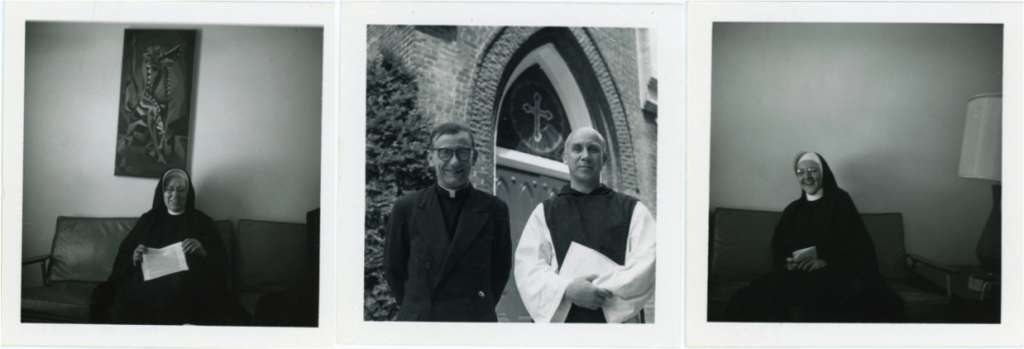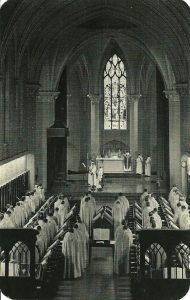LOREtto: Thomas Merton and Loretto
Posted on July 27, 2018, by Loretto Community
By Susanna Pyatt
2018 marks the 50th anniversary of Thomas Merton’s death. As a monk at the Abbey of Gethsemani, Merton was a neighbor of the Sisters at the Loretto Motherhouse. The Heritage Center is currently planning an exhibit for this fall that highlights the friendship, mentorship, and dialogue between Merton and the Sisters of Loretto in the 1960s.
Merton first visited the Motherhouse in October 1960, seeking a teaching position for Daniel Walsh, who had been his philosophy professor at Columbia University. Loretto benefitted not only from having Walsh as a teacher, but also from having other speakers and guests brought by Merton to speak to the novices. These included poet and activist Daniel Berrigan, SJ, and theologian Jean Daniélou, SJ. These contacts helped shape the novices’ perspectives as they learned about different theological philosophies, social justice activism, and other faith matters.

In bringing Walsh to Loretto, Merton met Superior General Mary Luke Tobin, and the two began a deep friendship (discussed more in the upcoming exhibit). Merton also communicated with the Loretto novices. He spoke to them about prayer and modern religious life, exchanged letters, and encouraged them in pursuing their vocations. Merton was highly affirmative of life at Loretto. For example, writing to the young Sisters at the new novitiate in Colorado in 1964, Merton spoke of the unusually good atmosphere provided by the Sisters, “where it is understood and taken for granted that sisters are also human and alive.”
Merton spoke of the unusually good atmosphere provided by the Sisters, “where it is understood and taken for granted that sisters are also human and alive.”
Gifts exchanged
Material objects were also part of the exchange between Merton and Loretto. Merton and Mary Luke sent each other books to read, and Mary Luke sent him a relic of a Lebanese Maronite Saint, Charbel Makhlouf, while she was attending Vatican II. At the end of 1960, Merton sent the novices a copy of his book Nativity Kerygma and an item he described as an “ancient snuff jar.” He requested that the Loretto novices make tables for the novitiate chapel and sacristy at Gethsemani.
The Heritage Center has two objects Merton gave to Loretto. When the church at Gethsemani was being renovated in the 1960s, Merton gave an original consecration cross and brass sconce to Sr. Helen Jean Seidel. Helen Jean was Mistress of Novices from 1958 to 1968; in this role she had come to know Merton because of his communications with the Loretto novices. These objects remain in the Heritage Center collections as a symbol of Merton’s relationship with the Sisters of Loretto.

The abbatial church at Gethsemani, designed by architect William Keely, was consecrated by Archbishop John Baptist Purcell in 1866. Twelve consecration crosses were placed on the interior of the church walls to mark where the Archbishop anointed them during the dedication ritual. Each one had an associated sconce to hold a candle. Traditionally in the Catholic Church, such candles are re-lit as part of annual consecration celebrations and also sometimes to mark certain Church feast days.

The removal of these items from Gethsemani signifies broader changes in the Catholic Church that occurred in the 1960s. During this decade, the church at Gethsemani was renovated from its original Gothic style to a stripped-down, simple style known as Brutalism. Such changes followed both contemporary architectural trends and the liturgical changes instituted by Vatican II. The chapel at the Loretto Motherhouse also underwent extensive renovations following Vatican II, though the Loretto renovation project did not occur until 1980.
Merton’s and the Loretto Sisters’ choices of gifts to one another during the 1960s are interesting. In the midst of their concerns about religious congregational renewal, new social justice missions, and the major liturgical and organizational changes affirmed by Vatican II, they still valued the past as they exchanged saints’ relics and 19th-century consecration markers.
Share your stories!
If you have memories of Thomas Merton at Loretto that you would like to share, the Heritage Center would love to hear your stories! We are collecting brief oral histories to include with the upcoming exhibit. Please contact the Curator, Susanna Pyatt, at [email protected] or call the Heritage Center at (270) 865-5811 ext. 3151.
